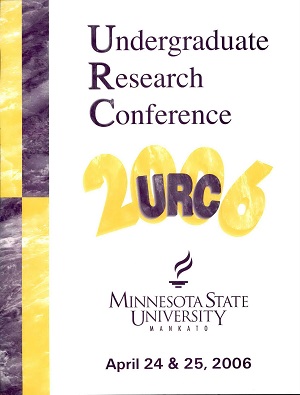The Articulatory Loop and Age-Related Differences in the Processing of Rapidly Presented Visual Information
Location
CSU North Ballroom
Start Date
24-4-2006 1:30 PM
End Date
24-4-2006 3:30 PM
Student's Major
Psychology
Student's College
Social and Behavioral Sciences
Mentor's Name
Robert L. Widner
Mentor's Department
Psychology
Mentor's College
Social and Behavioral Sciences
Description
We know from unpublished work that visual information processing is negatively impacted during the early stages of Alzheimer's disease (AD). Recently we have observed age-related differences in the processing of rapidly presented visual information (e.g., letter presentations at 110 msec each) with older adults (mean age = 76) taking three times longer than young adults (mean age =18). We know that as one ages there is a deterioration in working memory performance. Thus, in the present study we examined one component of working memory - the articulatory loop to determine its role in the observed age-related difference. Participants were asked to identify a single white letter embedded in a sequence of black letters with each letter appearing in the center of the monitor for 110 msec. Participants were asked to report the white letter and whether a probe item (a black 'X') followed the white letter (across trials probe was present half of the time). Half of the participants were required to repeat the word "the" at one second intervals until they reported the information whereas the reaming participants did not repeat the word. We observed that the processing rate mirrored that of older adults for those who repeated "the". Thus, it appears that the articulatory loop plays a significant role in the age-related differences observed in our lab. Our next step is to include mild AD patients to see if they produce a patter similar to that observed by young adults who had the articulatory loop loaded (saying "the").
The Articulatory Loop and Age-Related Differences in the Processing of Rapidly Presented Visual Information
CSU North Ballroom
We know from unpublished work that visual information processing is negatively impacted during the early stages of Alzheimer's disease (AD). Recently we have observed age-related differences in the processing of rapidly presented visual information (e.g., letter presentations at 110 msec each) with older adults (mean age = 76) taking three times longer than young adults (mean age =18). We know that as one ages there is a deterioration in working memory performance. Thus, in the present study we examined one component of working memory - the articulatory loop to determine its role in the observed age-related difference. Participants were asked to identify a single white letter embedded in a sequence of black letters with each letter appearing in the center of the monitor for 110 msec. Participants were asked to report the white letter and whether a probe item (a black 'X') followed the white letter (across trials probe was present half of the time). Half of the participants were required to repeat the word "the" at one second intervals until they reported the information whereas the reaming participants did not repeat the word. We observed that the processing rate mirrored that of older adults for those who repeated "the". Thus, it appears that the articulatory loop plays a significant role in the age-related differences observed in our lab. Our next step is to include mild AD patients to see if they produce a patter similar to that observed by young adults who had the articulatory loop loaded (saying "the").
Recommended Citation
Bozhinova, Rachael. "The Articulatory Loop and Age-Related Differences in the Processing of Rapidly Presented Visual Information." Undergraduate Research Symposium, Mankato, MN, April 24, 2006.
https://cornerstone.lib.mnsu.edu/urs/2006/poster-session-C/7



